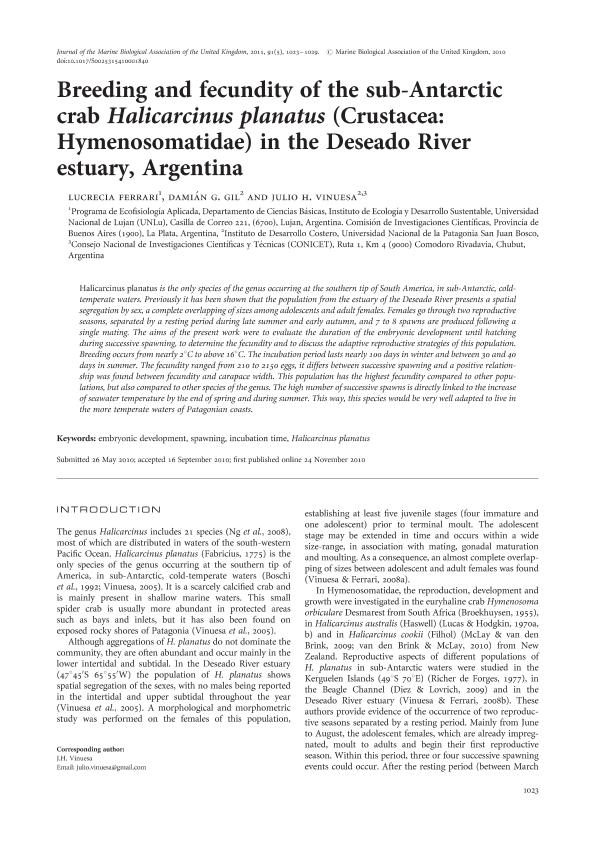Mostrar el registro sencillo del ítem
dc.contributor.author
Ferrari, Lucrecia

dc.contributor.author
Gil, Damian Gaspar

dc.contributor.author
Vinuesa, Julio Hector

dc.date.available
2019-09-27T20:38:54Z
dc.date.issued
2011-05
dc.identifier.citation
Ferrari, Lucrecia; Gil, Damian Gaspar; Vinuesa, Julio Hector; Breeding and fecundity of the sub-Antarctic crab Halicarcinus planatus (Crustacea: Hymenosomatidae) in the Deseado River estuary, Argentina; Cambridge University Press; Journal of the Marine Biological Association of the United Kingdom; 91; 5; 5-2011; 1023-1029
dc.identifier.issn
0025-3154
dc.identifier.uri
http://hdl.handle.net/11336/84725
dc.description.abstract
Halicarcinus planatus is the only species of the genus occurring at the southern tip of South America, in sub-Antarctic, cold-temperate waters. Previously it has been shown that the population from the estuary of the Deseado River presents a spatial segregation by sex, a complete overlapping of sizes among adolescents and adult females. Females go through two reproductive seasons, separated by a resting period during late summer and early autumn, and 7 to 8 spawns are produced following a single mating. The aims of the present work were to evaluate the duration of the embryonic development until hatching during successive spawning, to determine the fecundity and to discuss the adaptive reproductive strategies of this population. Breeding occurs from nearly 2°C to above 16°C. The incubation period lasts nearly 100 days in winter and between 30 and 40 days in summer. The fecundity ranged from 210 to 2150 eggs, it differs between successive spawning and a positive relationship was found between fecundity and carapace width. This population has the highest fecundity compared to other populations, but also compared to other species of the genus. The high number of successive spawns is directly linked to the increase of seawater temperature by the end of spring and during summer. This way, this species would be very well adapted to live in the more temperate waters of Patagonian coasts.
dc.format
application/pdf
dc.language.iso
eng
dc.publisher
Cambridge University Press

dc.rights
info:eu-repo/semantics/openAccess
dc.rights.uri
https://creativecommons.org/licenses/by-nc-sa/2.5/ar/
dc.subject
EMBRYONIC DEVELOPMENT
dc.subject
HALICARCINUS PLANATUS
dc.subject
INCUBATION TIME
dc.subject
SPAWNING
dc.subject.classification
Biología Marina, Limnología

dc.subject.classification
Ciencias Biológicas

dc.subject.classification
CIENCIAS NATURALES Y EXACTAS

dc.title
Breeding and fecundity of the sub-Antarctic crab Halicarcinus planatus (Crustacea: Hymenosomatidae) in the Deseado River estuary, Argentina
dc.type
info:eu-repo/semantics/article
dc.type
info:ar-repo/semantics/artículo
dc.type
info:eu-repo/semantics/publishedVersion
dc.date.updated
2019-09-20T15:12:24Z
dc.journal.volume
91
dc.journal.number
5
dc.journal.pagination
1023-1029
dc.journal.pais
Reino Unido

dc.journal.ciudad
Cambridge
dc.description.fil
Fil: Ferrari, Lucrecia. Universidad Nacional de Luján. Departamento de Ciencias Básicas. Programa de Ecofisiología Aplicada; Argentina
dc.description.fil
Fil: Gil, Damian Gaspar. Universidad Nacional de Luján. Departamento de Ciencias Básicas. Programa de Ecofisiología Aplicada; Argentina
dc.description.fil
Fil: Vinuesa, Julio Hector. Consejo Nacional de Investigaciones Científicas y Técnicas; Argentina. Universidad Nacional de la Patagonia "San Juan Bosco". Instituto de Desarrollo Costero; Argentina
dc.journal.title
Journal of the Marine Biological Association of the United Kingdom

dc.relation.alternativeid
info:eu-repo/semantics/altIdentifier/doi/http://dx.doi.org/10.1017/S0025315410001840
dc.relation.alternativeid
info:eu-repo/semantics/altIdentifier/url/https://bit.ly/2nOYp5F
Archivos asociados
